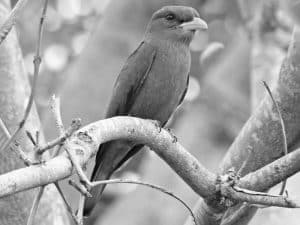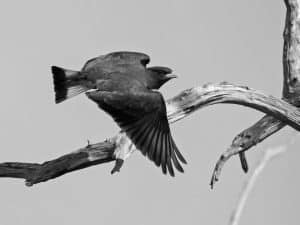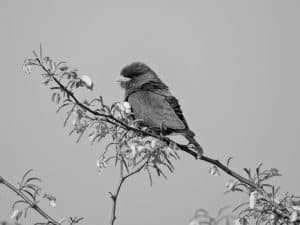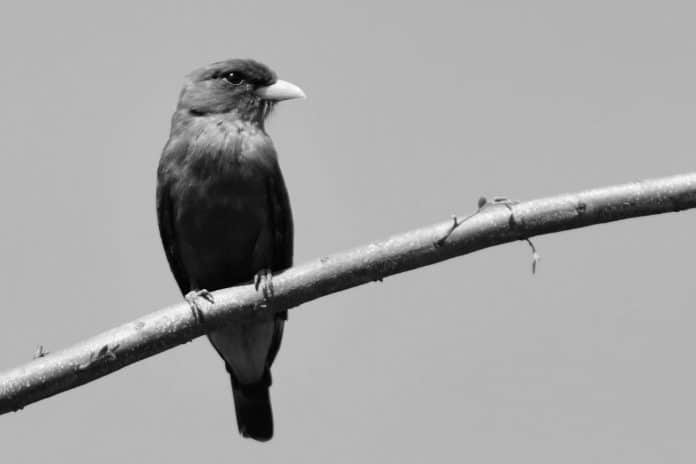Introduction to the Broad-Billed Roller
Welcome to the captivating world of the broad-billed roller, a stunning bird species that graces the Tanzanian landscapes with its mesmerizing flight and vibrant plumage. The broad-billed roller in Tanzania, scientifically known as Eurystomus glaucurus, is a member of the roller family and is celebrated for its striking appearance and graceful aerial displays. Found predominantly in the eastern and southern regions of Africa, the broad-billed roller is a beloved symbol of the avian diversity that thrives in Tanzania’s rich ecosystems.

The broad-billed roller boasts a distinctive appearance, characterized by its vibrant plumage and remarkable aerial acrobatics. Sporting a cobalt blue crown, a warm russet back, and a broad, sturdy beak, this avian wonder is a sight to behold against the backdrop of Tanzania’s diverse landscapes. As we delve deeper into the world of the broad-billed roller, we will explore its habitat, behaviors, conservation status, and the vital role it plays in Tanzanian ecosystems.
The Broad-Billed Roller’s Habitat in Tanzania
Tanzania, a country renowned for its breathtaking natural beauty and diverse wildlife, provides an ideal habitat for the broad-billed roller. This enchanting bird species can be found in a range of habitats, including open woodlands, savannas, and forest edges. With its preference for areas with scattered trees and shrubs, the broad-billed roller thrives in the diverse ecosystems that characterize Tanzania’s landscapes.
One of the key habitats for the broad-billed roller in Tanzania is the iconic Serengeti National Park, where the bird’s striking colors stand out amidst the vast plains and acacia woodlands. Additionally, the lush and verdant landscapes of the Selous Game Reserve provide another haven for these beautiful birds. The broad-billed roller’s adaptability to various habitats allows it to carve out a niche in Tanzania’s natural environments, making it a cherished resident of the country’s avian community.
The diverse habitats that the broad-billed roller inhabits in Tanzania not only showcase the bird’s adaptability but also offer birdwatching enthusiasts and nature lovers the opportunity to witness its captivating presence in different settings. As we explore the behaviors and characteristics of the broad-billed roller, we gain a deeper appreciation for its role in Tanzania’s vibrant ecosystems.
Behaviors and Characteristics of the Broad-Billed Roller
The broad-billed roller is renowned for its captivating behaviors and striking characteristics, making it a fascinating subject for bird enthusiasts and researchers alike. With its impressive aerial displays and melodious calls, the bird adds an enchanting dimension to Tanzania’s natural tapestry. During the breeding season, the broad-billed roller showcases its remarkable courtship rituals, which often involve intricate aerial maneuvers and vivid displays of its iridescent plumage.
Known for its distinctive rolling flight pattern, the broad-billed roller elegantly twists and turns through the air, showcasing its agility and grace. Its vibrant hues, including the stunning contrast between the cobalt blue crown and the warm russet back, make it a visual spectacle against the backdrop of Tanzania’s diverse landscapes. These striking characteristics and behaviors underscore the broad-billed roller’s significance as a symbol of beauty and vitality in Tanzanian ecosystems.
Conservation efforts play a crucial role in safeguarding the broad-billed roller and ensuring the preservation of its natural habitats. As we delve into the conservation status of the broad-billed roller in Tanzania, we gain insight into the challenges and initiatives aimed at protecting this remarkable bird species.
Conservation Status of the Broad-Billed Roller in Tanzania

The conservation status of the broad-billed roller in Tanzania is of paramount importance, given the threats posed to its habitats and populations. As a species that relies on diverse ecosystems for its survival, the broad-billed roller faces challenges such as habitat loss, deforestation, and human encroachment. These factors contribute to the vulnerability of the bird and necessitate concerted efforts to protect its habitats and ensure its continued presence in Tanzania’s natural landscapes.
In recognition of the significance of the broad-billed roller, conservation organizations and wildlife authorities in Tanzania have undertaken initiatives to monitor and safeguard the bird’s populations. These efforts include habitat conservation, community engagement, and research projects aimed at understanding the ecological requirements of the broad-billed roller. By raising awareness about the importance of preserving the bird’s habitats and addressing the underlying threats, conservationists are working towards securing a sustainable future for the broad-billed roller in Tanzania.
The role of the broad-billed roller in Tanzanian ecosystems extends beyond its visual appeal, as it contributes to the intricate balance of biodiversity and ecological dynamics. As we delve into the bird’s ecological significance, we uncover the interconnectedness of species and habitats in Tanzania’s natural environments.
The Role of the Broad-Billed Roller in Tanzanian Ecosystems
The broad-billed roller plays a vital role in Tanzanian ecosystems, contributing to the pollination of plants and the regulation of insect populations. As an insectivorous bird, it preys on a variety of insects, including grasshoppers, beetles, and caterpillars, thereby helping to control insect populations in its habitat. Additionally, the broad-billed roller’s foraging activities contribute to the ecological balance of the ecosystems it inhabits, making it an integral part of Tanzania’s natural heritage.
Beyond its ecological contributions, the broad-billed roller also serves as an indicator species, reflecting the health of its habitats and the broader environmental conditions. By monitoring the populations and behaviors of the bird, researchers and conservationists gain valuable insights into the state of Tanzania’s ecosystems and the impacts of environmental changes. This underscores the importance of protecting the broad-billed roller and preserving the habitats that sustain its presence in Tanzania.
The diverse landscapes of Tanzania offer prime opportunities for birdwatching enthusiasts and nature photographers to witness the beauty of the broad-billed roller in its natural environment. As we explore the best locations for birdwatching the broad-billed roller in Tanzania, we uncover the allure of these pristine habitats and the enchanting experiences they offer.
Best Locations for Birdwatching the Broad-Billed Roller in Tanzania
Tanzania is renowned for its rich biodiversity and diverse landscapes, providing an array of exceptional locations for birdwatching the broad-billed roller. The Serengeti National Park, with its sweeping plains and acacia woodlands, offers a magnificent backdrop for observing the bird’s aerial displays and foraging activities. The park’s expansive vistas and diverse wildlife make it a prime destination for encountering the broad-billed roller in its natural habitat.
Another prominent location for birdwatching the broad-billed roller is the Selous Game Reserve, a UNESCO World Heritage Site that boasts an array of habitats, including woodlands, wetlands, and grassy plains. The reserve’s pristine wilderness and abundant birdlife create an immersive experience for nature enthusiasts seeking to witness the broad-billed roller’s captivating presence. These locations exemplify the allure of Tanzania’s natural landscapes and the opportunities they provide for experiencing the beauty of the broad-billed roller.
Photographing the broad-billed roller in Tanzania presents a unique opportunity to capture the bird’s vibrant colors and elegant flight maneuvers in stunning natural settings. As we delve into the art of photographing these avian wonders, we unravel the techniques and considerations that enhance the visual documentation of the broad-billed roller’s presence in Tanzania’s diverse ecosystems.
Photographing the Broad-Billed Roller in Tanzania
Capturing the essence of the broad-billed roller through photography requires a blend of technical skill, patience, and an understanding of the bird’s behaviors. The vibrant plumage and graceful flight patterns of the bird offer a wealth of photographic opportunities, whether in flight or perched amidst the scenic landscapes of Tanzania. To photograph the broad-billed roller in its natural habitat, one must consider factors such as lighting, composition, and the bird’s natural behaviors to create compelling and evocative images.
The soft, golden light of dawn and dusk often provides an ideal backdrop for photographing the broad-billed roller, accentuating its vibrant colors and creating a sense of warmth and serenity in the images. By observing the bird’s movements and behavior patterns, photographers can anticipate moments of aerial displays or foraging activities, capturing the dynamic essence of the broad-billed roller in its natural environment. Patience and a deep appreciation for the bird’s presence in the landscape are key elements in creating photographs that convey the beauty and vitality of the broad-billed roller in Tanzania.
The allure of photographing the broad-billed roller in Tanzania extends beyond visual documentation, as it fosters a deeper connection to the country’s natural heritage and the intrinsic value of its diverse ecosystems. As we explore the intersection of ecotourism and the broad-billed roller, we uncover the significance of responsible travel and conservation-oriented experiences that promote the bird’s preservation and the sustainability of Tanzania’s natural environments.
Ecotourism and the Broad-Billed Roller

Ecotourism offers a unique avenue for experiencing the beauty of the broad-billed roller in Tanzania while contributing to conservation efforts and sustainable practices. By engaging in responsible travel activities that prioritize the preservation of natural habitats and wildlife, visitors have the opportunity to appreciate the broad-billed roller’s presence in a manner that supports the bird’s conservation and the welfare of Tanzania’s ecosystems. This aligns with the principles of ecotourism, which emphasize environmental responsibility, cultural sensitivity, and community engagement.
Tanzania’s diverse array of national parks, game reserves, and protected areas provides a canvas for ecotourism experiences centered around the broad-billed roller and its fellow avian inhabitants. Through guided birdwatching excursions, nature walks, and educational programs, visitors can immerse themselves in the enchanting world of the broad-billed roller while gaining a deeper understanding of the ecological significance of the bird and its habitats. These experiences not only foster a sense of appreciation for Tanzania’s natural heritage but also contribute to the livelihoods of local communities and the preservation of the country’s biodiversity.
Efforts to protect the broad-billed roller in Tanzania encompass a range of initiatives aimed at conserving its habitats, raising awareness, and fostering sustainable coexistence between humans and wildlife. As we delve into the endeavors to safeguard the bird’s populations and habitats, we gain insight into the collaborative measures that support the broad-billed roller’s preservation and the broader conservation landscape in Tanzania.
Efforts to Protect the Broad-Billed Roller in Tanzania
Conservation organizations, wildlife authorities, and local communities in Tanzania are actively engaged in efforts to protect the broad-billed roller and ensure the sustainability of its habitats. These endeavors encompass habitat restoration, wildlife monitoring, and community-based conservation initiatives that seek to address the underlying threats to the bird’s populations. By fostering partnerships and collaborative action, stakeholders are working towards securing a future where the broad-billed roller thrives in Tanzania’s diverse ecosystems.
Community involvement plays a pivotal role in the conservation of the broad-billed roller, as local communities are integral to the stewardship of the bird’s habitats and the promotion of sustainable practices. Through education, capacity building, and the integration of local knowledge, conservation efforts strive to empower communities to become champions of the broad-billed roller’s preservation. By fostering a sense of shared responsibility and ownership, these initiatives contribute to the long-term sustainability of the bird’s populations and its habitats in Tanzania.
Conclusion
In conclusion, the broad-billed roller embodies the beauty and vitality of Tanzania’s natural landscapes, captivating observers with its vibrant colors and graceful aerial displays. As a symbol of the country’s rich avian diversity, the bird holds a special place in Tanzania’s ecosystems and cultural heritage. By embracing responsible ecotourism practices, supporting conservation initiatives, and advocating for the preservation of its habitats, we can ensure that the broad-billed roller continues to grace the Tanzanian landscapes for generations to come.

































